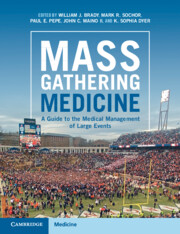Book contents
- Mass Gathering Medicine
- Mass Gathering Medicine
- Copyright page
- Dedication
- Contents
- Contributors
- Foreword
- Preface
- Chapter 1 An Introduction to Mass Gathering Medicine
- Chapter 2 Patient Care at Mass Gathering Events: Basic, Advanced, and Critical Care
- Chapter 3 Prediction of Medical Need and Event Risk Assessment at Mass Gathering Events
- Chapter 4 Medical Logistics and Operational Planning for Patient Care at Mass Gathering Events
- Chapter 5 Medical and Medical Support Staffing at Mass Gathering Events
- Chapter 6 Mass Gathering Medicine: Equipment and Planning Considerations
- Chapter 7 Incident Command System at Mass Gathering Events
- Chapter 8 Security and Other Nonmedical Logistical Support Issues at Mass Gathering Events
- Chapter 9 Understanding Local, State, and Federal Public Safety, Health Care, and Support Agencies
- Chapter 10 Common Themes and General Considerations across Mass Gathering Event Types
- Chapter 11 Mass Gathering Events: Youth, High School, Collegiate, Olympic, and Professional Sporting Events
- Chapter 12 Mass Gathering Events: Music Concerts and Festivals
- Chapter 13 Mass Gathering Events: Motor Sport Events
- Chapter 14 VIP and Executive Medicine Considerations at Mass Gathering Events
- Chapter 15 Mass Gathering Events: Community Events
- Chapter 16 Mass Gathering Events: Endurance Athletic Events
- Chapter 17 Mass Gathering Events: Extended Duration Events
- Chapter 18 At-Risk Populations within Mass Gathering Events
- Chapter 19 Crowd-Related Considerations at Mass Gathering Events: Management, Safety, and Dynamics
- Chapter 20 Civil Unrest and Terrorism Involving Mass Gathering Events
- Chapter 21 Impact of Weather and Climate Change on Mass Gathering Events
- Chapter 22 Occurrence of the Mass Casualty Incident at a Mass Gathering Event
- Chapter 23 Touring Medicine
- Chapter 24 Infectious Disease and Mass Gathering Medicine
- Chapter 25 Toxicology and Mass Gathering Medicine
- Chapter 26 Medicolegal Considerations in Mass Gathering Medicine
- Chapter 27 Business Considerations in Mass Gathering Medicine
- Index
- References
Chapter 9 - Understanding Local, State, and Federal Public Safety, Health Care, and Support Agencies
Published online by Cambridge University Press: 11 April 2024
- Mass Gathering Medicine
- Mass Gathering Medicine
- Copyright page
- Dedication
- Contents
- Contributors
- Foreword
- Preface
- Chapter 1 An Introduction to Mass Gathering Medicine
- Chapter 2 Patient Care at Mass Gathering Events: Basic, Advanced, and Critical Care
- Chapter 3 Prediction of Medical Need and Event Risk Assessment at Mass Gathering Events
- Chapter 4 Medical Logistics and Operational Planning for Patient Care at Mass Gathering Events
- Chapter 5 Medical and Medical Support Staffing at Mass Gathering Events
- Chapter 6 Mass Gathering Medicine: Equipment and Planning Considerations
- Chapter 7 Incident Command System at Mass Gathering Events
- Chapter 8 Security and Other Nonmedical Logistical Support Issues at Mass Gathering Events
- Chapter 9 Understanding Local, State, and Federal Public Safety, Health Care, and Support Agencies
- Chapter 10 Common Themes and General Considerations across Mass Gathering Event Types
- Chapter 11 Mass Gathering Events: Youth, High School, Collegiate, Olympic, and Professional Sporting Events
- Chapter 12 Mass Gathering Events: Music Concerts and Festivals
- Chapter 13 Mass Gathering Events: Motor Sport Events
- Chapter 14 VIP and Executive Medicine Considerations at Mass Gathering Events
- Chapter 15 Mass Gathering Events: Community Events
- Chapter 16 Mass Gathering Events: Endurance Athletic Events
- Chapter 17 Mass Gathering Events: Extended Duration Events
- Chapter 18 At-Risk Populations within Mass Gathering Events
- Chapter 19 Crowd-Related Considerations at Mass Gathering Events: Management, Safety, and Dynamics
- Chapter 20 Civil Unrest and Terrorism Involving Mass Gathering Events
- Chapter 21 Impact of Weather and Climate Change on Mass Gathering Events
- Chapter 22 Occurrence of the Mass Casualty Incident at a Mass Gathering Event
- Chapter 23 Touring Medicine
- Chapter 24 Infectious Disease and Mass Gathering Medicine
- Chapter 25 Toxicology and Mass Gathering Medicine
- Chapter 26 Medicolegal Considerations in Mass Gathering Medicine
- Chapter 27 Business Considerations in Mass Gathering Medicine
- Index
- References
Summary
Nearly every special event or mass gathering of sufficient size to warrant dedicated medical services will likely have opportunities to interface with other agencies and organizations providing support services. In general, the larger or more complex the event, the more agencies will be involved. Law enforcement, most often local, is almost always involved in the planning and operations of a special event. Other public safety agencies such as local or mutual aid emergency medical services (EMS), the fire service, and emergency management are also commonly involved. It is important that event medical planners and leaders also interface with local and regional hospitals, including those providing specialty services for important time-critical problems (e.g., trauma, cardiac, stroke, etc.). When event venues are in rural areas, more distant from hospitals, including the area helicopter EMS provider(s) in planning is important, and often neglected. There are a number of other local, state, federal, and private organizations that may be involved in event planning and operations. This chapter is intended to provide an overview of many of these important partners that help to assure the event has sufficient resources to provide safety and security to all.
- Type
- Chapter
- Information
- Mass Gathering MedicineA Guide to the Medical Management of Large Events, pp. 105 - 119Publisher: Cambridge University PressPrint publication year: 2024



